

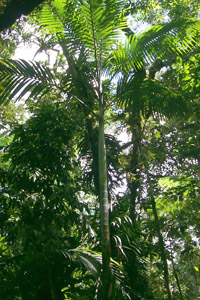
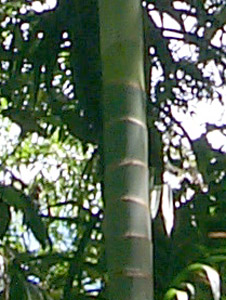
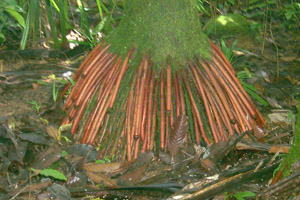
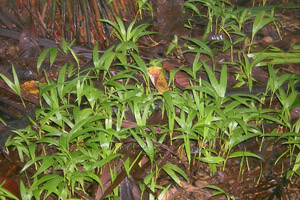
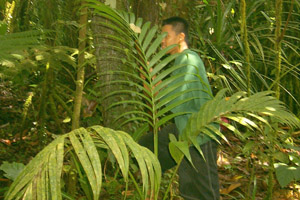
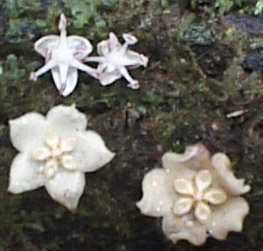
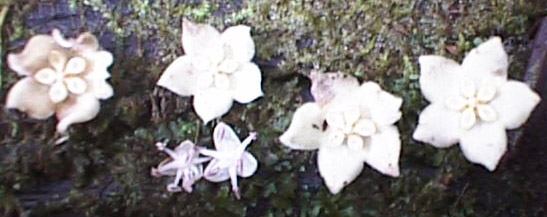
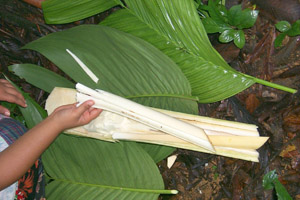
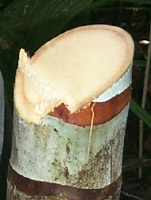
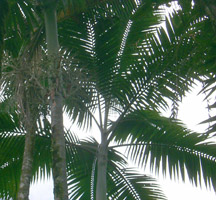
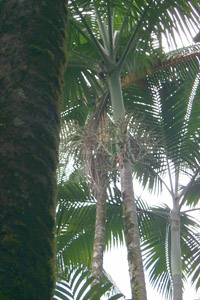
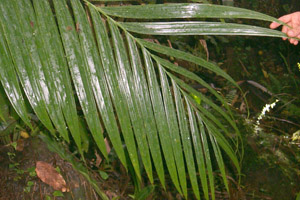
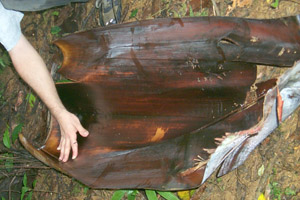
Description not yet done.
Kotop is been very important for Pohnpeians since the very beginning until today. However, nowadays, this plant is important especially for those who live a subsistence life, those who are dependant on the land (crops) for living. In many cases when Pohnpeians go to the forest, they do not bring any tents or sleeping bags with them. They know that there are shelters available up there for them. Pohnpeians use kotop for shelter and also for food. They also use the crown shaft for carrying things, like wild yam. The kids use the crown shaft as toys, too. This is how they play with it. One kid will get onto the crown shaft and the other or the rest pull it or if it is on a hill, they'll just sit in it and play the local 'skate' down hill, note: no up-hill. This plant is very important in so many ways.
This is how Pohnpeians make a shelter using this plant. They simply take plenty kotop leaves and place them over a line or a long wood about 4-5 feet above the ground but horizontal to the ground. That only protects you from rain and sun. It is very comfortable too because you do not have to bring it from a distant area. These plants are available just at your side, right and left, in front of you and at your back every time you look back. When our grandparents and some people today go up to the forest to do their work, they do not bring any food or drinks with them because they know that their needs are available. And guess what, Kotop is one of those plenty plants that forest-people depended on and still depending on, for shelter, food, and for drink.
The very good advantage of this plant is that not only the people are benefiting from it but also our animals. Our animals like pigs and deer also depend on this plant. Pohnpeians feed their pigs with kotop. The deer eat it too. They do their own way of getting their food from the plant. I believe that they also eat the part that the people eat also. Why? Because many times when I go up to the forest, I found young kotop plants ripped apart and the part that people eat is the only part gone. On the other hand, Pohnpeians take the wooden part of the trunk and lay down the floor of their local hut. The same part can be used to construct the wall, shelf (pasapas), chair, table and many other things. This plant has some medicinal uses. But unfortunately they are kept very confidential.
Long time ago, there were foreigners that came to Pohnpei, (I am not sure where they were from) and before they actually got up on the land, they turned back and ran away. Why did they run away? Because when they reached the shore, they looked up to the mountains and saw big kotop plants thinking that they were giant men in grass skirts. They were so scared of such huge beings that they simply turned back and ran away. If you take a look at the roots of this plant, it is structured like a grass skirt especially if you are a little farther away from it.
Once, there was a lady (water eel) called Lasi lived in Pohnpei. She had plenty children and three of them were Lasidohng, Lasikotop and Lasialap. Her children were there to make life possible. Lasidohng was responsible for firewood and making canoes. Lasikotop’s job was to provide food, shelter and do a little help out in the health care of the family. And Lasialap was the last one to be formed (by the way, all these children were made). Lasialap was a being. So, Lasikotop was their food if you get the story.
Compare this story with the beginning of life in the bible, in the book of Genesis. Maybe you’ll get what I am trying to say here. I just mentioned the part where kotop comes to play. Keep in mind that I only mentioned three of the many children.
- Dalihlu Waltu 2000